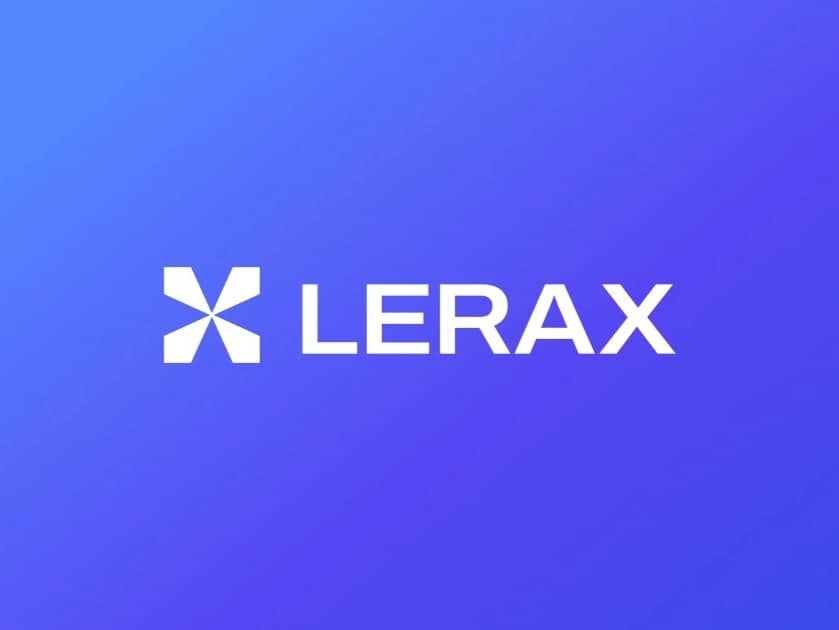订阅 wiki
Share wiki
Bookmark
LERAX
LERAX
LERAX 是一个旨在促进现实世界资产 (RWA)代币化的区块链平台。该项目旨在通过在其网络上将实物和金融资产表示为数字代币,从而将传统金融资产与去中心化金融 (DeFi)生态系统连接起来。[2]
概述
LERAX Chain 是一个 Layer 1 权威证明 区块链,专门设计用于将 400 万亿美元的现实世界资产经济与去中心化金融集成。它通过 KYC 验证机构网络实现实物资产(包括房地产、商品、债券和知识产权)的合规代币化,从而确保监管的最终性。该平台支持具有服务级别协议的无 Gas 企业交易,用于大批量结算、具有法律约束力的智能合约以及低至微股的零星所有权,并自动分配股息。此外,LERAX Chain 通过混合子网和用于资产估值、所有权验证和透明链上结算的现实世界预言机馈送,整合了符合 GDPR 的隐私功能。[1]
特点
权威证明共识
LERAX Chain 是一个 Layer 1 区块链,专为现实世界资产的代币化而构建,旨在在可扩展性、安全性和合规性之间取得平衡。其模块化架构能够灵活部署企业级功能,从而实现对资产(包括房地产、商品、债券和知识产权)的透明且可审计的管理。该平台旨在支持大批量结算、零星所有权和具有法律约束力的智能合约,从而为机构和政府采用提供全面的基础设施。
该链使用权威证明 (PoA) 共识机制,其中一组预先批准的、经过 KYC 验证的验证者被授权验证交易并生成区块。这种方法可实现即时最终性,在几秒钟内确认交易,同时与 工作量证明 系统相比,消耗的能量极少。PoA 还增强了安全性,因为验证者是已知的且经过审查的实体,从而减少了潜在的攻击面,并确保了需要可识别参与者的司法管辖区的监管一致性。通过结合这些要素,LERAX Chain 创建了一个可靠、高效且合规的环境,用于将现实世界资产引入区块链。[3]
RWA 代币化
LERAX 为机构提供基础设施,以代币化、管理和交易现实世界资产,并具有监管透明度和链上可审计性。该平台支持银行、资产管理公司、私募股权公司、学术机构和代币化资产交易所,提供合规代币发行、KYC/AML、资产审计和安全多重签名钱包的工具。
主要功能包括用于所有权证明的链上注册表、用于代币化、收入分成和债务发行的智能合约模板,以及用于审计师验证资产支持的储备证明框架。LERAX 还促进零星资产交易、受监管的二级市场上市、实时价格发现和流动性提供,并计划在新加坡、欧洲和美国进行整合。学术和研究合作伙伴关系进一步支持风险建模、法律框架、混合 DeFi-RWA 产品和治理模拟。[4]
LERAX 节点
LERAX 节点是 LERAX 生态系统中的一个特殊参与者,在权威证明共识模型下运行,其中一组选定的受信任机构验证交易,而不是竞争区块生产。节点持有者支持快速、安全和低成本的区块链运营,同时参与治理、奖励分配和现实世界资产创新。
LERAX 节点充当生态系统的治理锚点,授予持有者对社区提案、协议升级和资金分配的投票权。它们还提供对新合作伙伴关系、代币化资产上市和 RWA 投资的早期访问权限,同时直接链接到基于层级的奖励的代币排放机制。其他特权包括大使计划的资格以及影响 LERAX 路线图和资产选择的能力。[5]
治理
LERAX Chain 由一个去中心化自治组织 (DAO)管理,该组织支持社区主导的决策和长期网络可持续性。节点运营商和核心贡献者参与链上治理,所有提案、投票、结果、资金转移和里程碑都可以通过 LERAX Explorer 完全审计。[6]
代币经济学
LERAX 的固定总供应量为 1000 亿个代币,旨在支持生态系统增长、核心基础设施和贡献者奖励。所有代币移动在 LERAX 区块链 浏览器上都是完全透明且可追踪的,其中标记的钱包用于质押、流动性和生态系统基金等类别。这允许用户验证分配、使用情况和解锁时间表。分配如下:[7]
- 团队: 1%
- 节点奖励: 30%
- RWA 储备: 20%
- 质押奖励: 10%
- 流动性池: 15%
- 生态系统基金: 14%
- CEX 上市: 5%
- 空投: 5%
合作伙伴
- Spiko
- EMAAR
- Circle
- Apollo
- Centrifuge
- Fidelity
- Hamilton Lane
- Libre
- Arichain
- IQ.wiki
- Web3 Decision
发现错误了吗?
